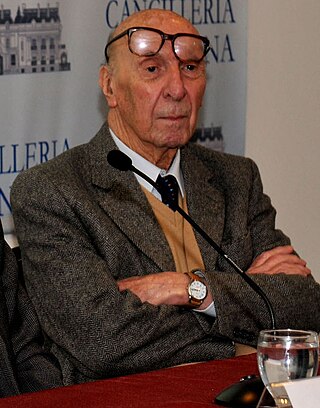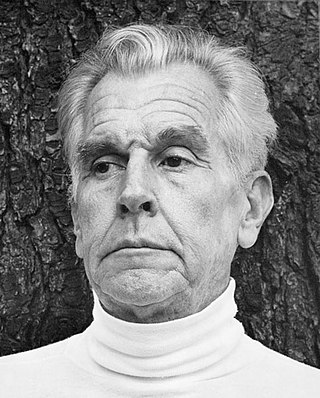Related Research Articles

The University of Buenos Aires is a public research university in Buenos Aires, Argentina. It was established in 1821. It has educated 17 Argentine presidents, produced four of the country's five Nobel Prize laureates, and is responsible for approximately 40% of the country's research output.

The Torcuato Di Tella University is a non-profit private university in Buenos Aires, Argentina. Founded in 1991, the university focused primarily on social sciences.
Moreno is a city in Buenos Aires Province, Argentina. It is the head town of Moreno Partido. It forms part of the Greater Buenos Aires urban conurbation and is located around 36 km (22 mi) to the west of the autonomous city of Buenos Aires.

The Kavanagh Building is a residential skyscraper in Retiro, Buenos Aires, Argentina. Designed in 1934 by architects Gregorio Sánchez, Ernesto Lagos and Luis María de la Torre, it is considered a pinnacle of modernist architecture. At the time of its inauguration in 1936, the Kavanagh was the tallest building in Latin America surpassing the Palacio Salvo built in Montevideo, Uruguay in 1928, as well as the tallest building in the world with a reinforced concrete structure.

The architecture of Argentina can be said to start at the beginning of the Spanish colonisation, though it was in the 18th century that the cities of the country reached their splendour. Cities like Córdoba, Salta, Mendoza, and also Buenos Aires conserved most their historical Spanish colonial architecture in spite of their urban growth.

The Curutchet House, La Plata, Argentina, is a building by Le Corbusier. It was commissioned by Dr. Pedro Domingo Curutchet, a surgeon, in 1948 and included a small medical office on the ground floor. The house consists of four main levels with a courtyard between the house and the clinic. The building faces the Paseo del Bosque park. The main facade incorporates a brise soleil.

Clorindo Manuel José Testa was an Italian-Argentine architect and artist.
Diana I. Agrest is a practicing architect and urban designer and an architecture and urban design theorist, in New York City.

Alberto Prebisch was a distinguished Argentine architect whose numerous works included private houses, apartment and office blocks, cinemas, shops and banks. Prebisch was born in Tucumán, Argentina, to German settlers his brother Raúl Prebisch was a well-known economist.

Amancio Williams was an Argentine architect. He is among his country's leading exponents of modern architecture.

Cristina Álvarez Rodríguez is an Argentine architect and politician, currently serving as Minister of Government and Infrastructure of Buenos Aires Province, under Governor Axel Kicillof. She was previously a National Deputy representing Buenos Aires Province from 2015 to 2021. A great-niece of Eva Perón, she belongs to the peronist Justicialist Party.

The Buenos Aires Central Post Office building, now the "Palacio Libertad", was the seat of the Correo Argentino until 2002. It is located in the San Nicolás, Buenos Aires neighborhood of Buenos Aires, Argentina. The building was designed in the Neoclassical Beaux-Arts style and with Second Empire style elements by French architect Norbert Maillart.
Mario I. Gandelsonas is an Argentine-American architect and theorist whose specializations include urbanism and semiotics.
Filandia Elisa Pizzul was the first woman to graduate from a school of architecture in Argentina. She organized the library of the Faculty of Architecture of Buenos Aires and was its first director. A room is named after her.

Sergio Castiglione is an Argentine photographer. He has exhibited his work in Argentina as well as abroad. He mainly focuses on urban exploration, travel, and architectural photography.
Alberto Gorbatt is an architect at the Faculty of Architecture, Design and Urban Planning at the University of Buenos Aires.

Sonia Berjman is an urban and landscape historian, researcher on the history of Buenos Aires public space and protector of parks, squares, and public green spaces of that city, she is a acknowledged referent for these issues.
Wanda Dalla Costa is a practicing architect and professor who has been co-designing with North American indigenous communities for nearly two decades. Her teaching and research focuses include indigenous place-keeping, culturally responsive design, sustainable housing, and climate resiliency in architecture. Dalla Costa currently teaches at Arizona State University as Institute Professor and associate professor in The Design School and the School of Sustainable Engineering and the Built Environment. She is a member of Saddle Lake Cree Nation and the first First Nations woman architect in Canada. She is founding principal and owner of the firm, Redquill Architecture Inc., which is based in Phoenix, Arizona. She was one of eighteen indigenous architects representing Canada in the Venice Architecture Biennale 2018.

Fabiana Barreda is an Argentine photographer, performer, installationist and multimedia artist. Her work specializes in the body, desire and politics of gender. She has participated in national and international exhibitions, being the most important ones in places such as Museum of Modern Art, New York University (USA), International Architecture Biennale Rotterdam (Netherlands), Telefonica Foundation of Madrid (Spain) and Museum of Monterrey – MACO (Mexico).

The Faculty of Architecture, Design and Urbanism is a faculty of the University of Buenos Aires (UBA), the largest university in Argentina. Established in 1901 as the School of Architecture, it has since expanded to impart courses on graphic design and urbanism.
References
- Summa+ 56 y 156 Magazine -
- http://www.arqa.com/index.php/esc/claudio-vekstein-arquitecto.html